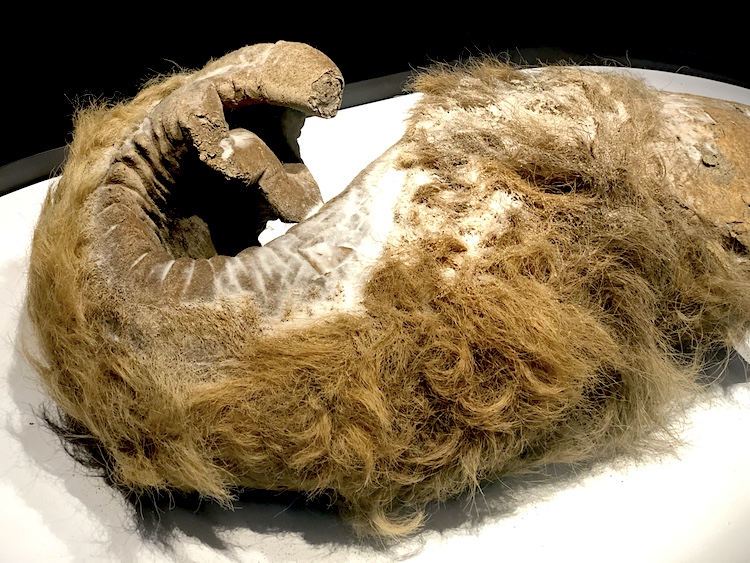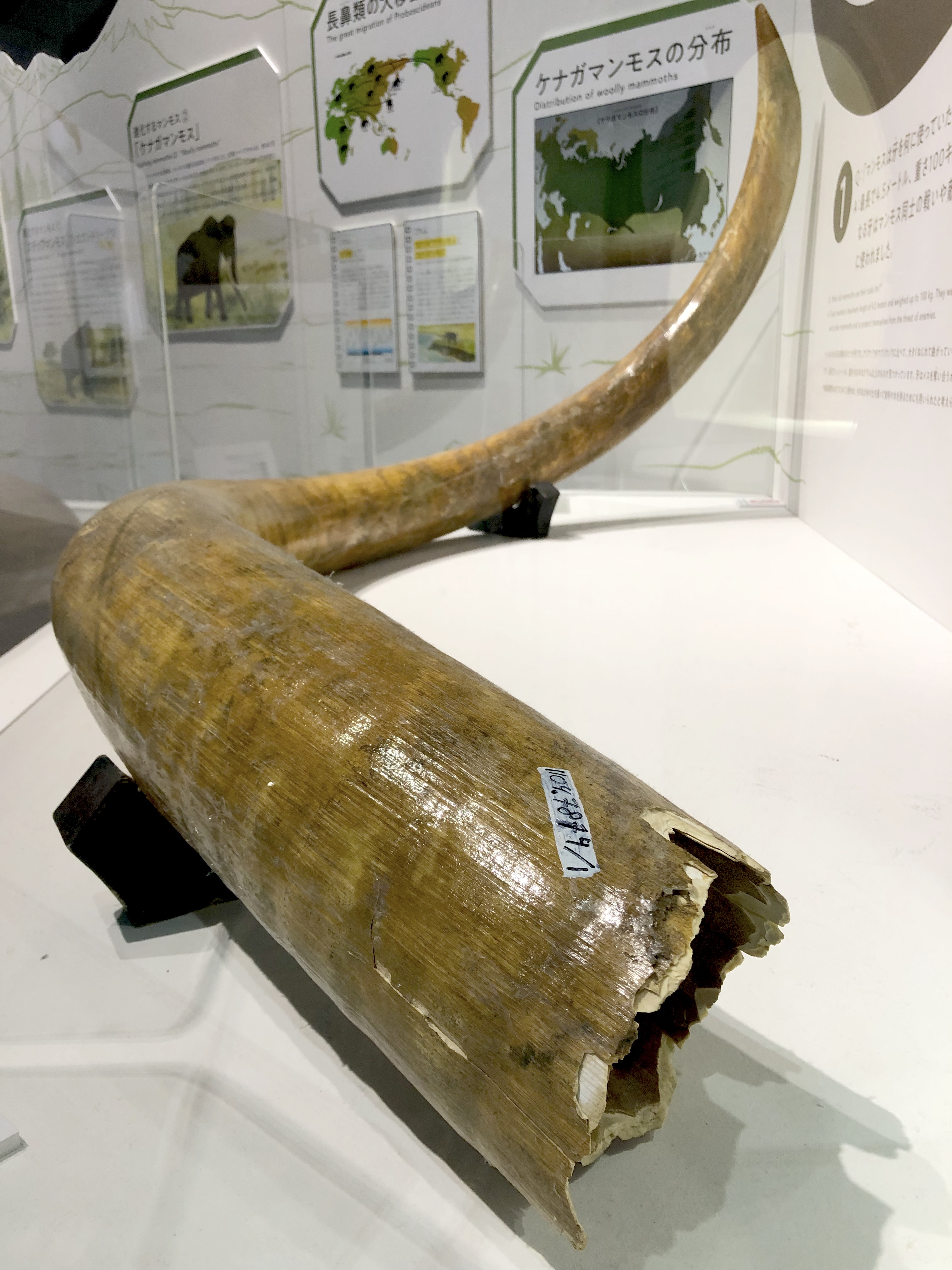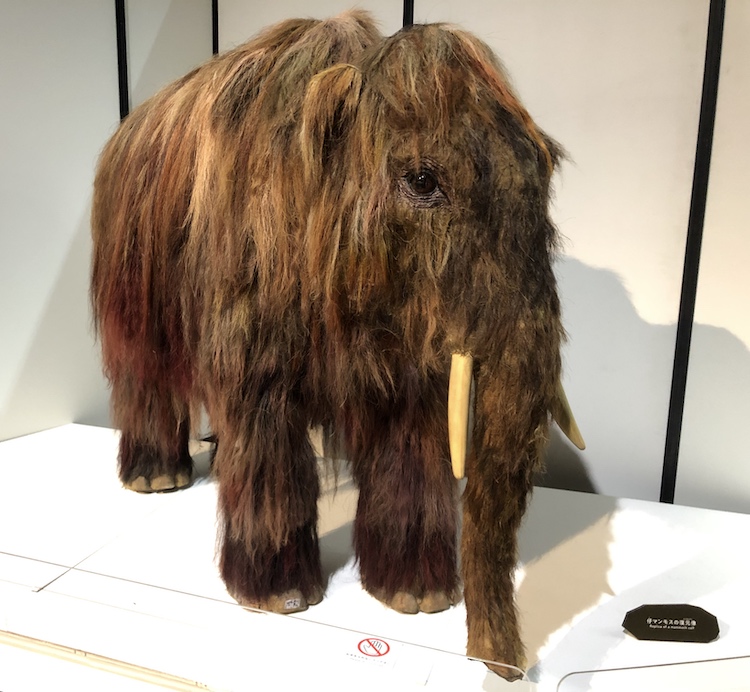When will we see the woolly mammoth 2.0?
Published 5 August 2019 by Cherise Fong
A new exhibition in Tokyo spotlights the woolly mammoth—its genealogy, its fossils, its genome, its de-extinction—in a media-savvy microcosm of the issues currently surrounding this extinct species of the Pleistocene era.
From our correspondent in Tokyo (words and photos)
The special exhibition at the National Museum of Emerging Science and Innovation (Miraikan) in Tokyo opens with Dima: the first well-preserved carcass of a woolly mammoth discovered in northeastern Siberia in 1977, a 7-month-old baby who died around 40,000 years ago. It’s a touching specimen, because even mummified through the millennia, we can still recognize the clear form of a little pachyderm, the lower legs covered with tufts of beige wool.

From June 7 to November 4, 2019, Miraikan is presenting a special exhibition entitled simply “The Mammoth”, letting the name of this iconic animal of the Pleistocene speak for itself. The exhibition features a complete skeleton, skull, jaw, tooth, even thick strands of wool that visitors can touch with their fingers. A genealogical chart shows the contemporary existence of the woolly mammoth (Mammuthus primigenius) with Homo Neanderthalensis and Homo Sapiens. Indeed, the last woolly mammoths, a dwarfed sub-species, survived on Wrangel Island until about 4,000 years ago—around the same time humans were building the Pyramids in Egypt or Stonehenge in England.
Several other Pleistocene species and specimens are also on exhibit, some for the very first time, including a woolly trunk from about 32,700 years ago discovered in 2013, and a large piece of woolly mammoth skin from about 31,150 years ago excavated during an expedition in Arctic Siberia in August 2018, led by Professor Hiromi Kato of Kindai University in Japan and extensively documented in the exhibition.
The last room is dedicated to the “Mammoth Revival Project” of Kindai University in Osaka. From a piece of tissue from the mouth of Yuka, a juvenile female woolly mammoth exceptionally well preserved since her death about 28,000 years ago and discovered in the Siberian village of Yukagir in 2010, the Japanese researchers performed a protein analysis to extract 43 cell nuclei, which they implanted in mouse ovocytes. Among these incubated cells, 5 displayed biological reactions characteristic of the beginning of cell division, according to their report published in March 2019.
Nucleus of woolly mammoth cell implanted in a mouse ovocyte, by Kindai University (2019):
While Kindai’s experiment may be exciting, it’s not quite conclusive. Nonetheless, the life-size model of a resuscitated woolly mammoth continues to attract family photos and selfies, rekindling dreams of the possibilities of life sciences.
Professor Miyamoto Hiroshi, evolutionary biologist and member of Kindai’s Mammoth team, declared: “Even recently in Japan, the wolf and the otter have become extinct. Currently, the extinction of species is accelerating. (…) This research project is about more than just understanding the life and death of the mammoth. Revealing the ecology of large mammals such as mammoths also helps us to predict what kind of impact climate change will have on life on Earth, and to protect creatures that are living now. Most importantly, biodiversity enriches our world. It’s also fun to imagine mammoths roaming the steppes in Siberia.”
So no illusions, but still an important contribution to science.
What is de-extinction?
Which brings us to the burning hot topic of de-extinction. While the term (not to mention the media) may evoke the pure and simple resurrection of an extinct species, the scientific notion is more nuanced. Genetic engineering researchers already know that the exact cloning of a specimen that has been dead for thousands of years is unrealistic (among many other reasons, because cells start to deteriorate as soon as the organism dies).

Unlike the Jurassic and Cretaceous dinosaurs, which have been extinct for some 66 million years, most Pleistocene woolly mammoths lived about only 11,000 years ago. Furthermore, Asian elephants are genealogically and genetically more closely related to mammoths than to African elephants.
More promising in terms of so-called de-extinction, according to practitioners, is the use of synthetic biology, more precisely CRISPR-Cas9, to recreate an artifical genome by inserting select genes extracted from bits of DNA from an extinct species, such as the woolly mammoth, whose cells have been more or less preserved in the ice. Afterward, the genome would need to be expressed in an embryo, which would need to develop inside a surrogate mother of a related species (in this case the Asian elephant) and be born (and grow up).
Since 2012, this has been the subject of a project in Russia, jointly led by researchers Semyon Grigoriev, director of the Mammoth Museum of the North-Eastern Federal University in Yakutsk in Sakha Republic (and who participated in the August 2018 expedition documented in the Miraikan exhibition), and Hwang Woo-Suk, South Korean cloning pioneer (convicted in 2006 of fraud and various bioethical violations…), founder of the dog-cloning company Sooam Biotech.

In the United States, George Church’s laboratory at Harvard University has been working since 2015 on creating a hybrid embryo composed of genes from both the woolly mammoth and the Asian elephant. He is supported by the non-profit organization Revive & Restore, under the banners of fighting climate change (reviving the woolly mammoth to restore the arctic ecosystem and prevent the ice from melting) and the “genetic rescue” of endangered elephants.
Because after scents, biofuels, biofabrics, vegetables, meat… and the successful resurrection of a flu virus that killed 50 million people in 1918, we might as well apply these new biotechnologies to the conservation of endanged species.
Pleistocene Park
Another reason why the woolly mammoth is a prime candidate for de-extinction: the “revived” species would already have its place on a nature reserve in the Siberian tundra. The reserve is called Pleistocene Park, and it contains 16 hectares of protected land owned by the Russian ecologist Sergey Zimov and his son Nikita, who have already reintroduced wild herds of bison, musk ox, moose, horses and reindeer. By grazing year-round, these large herbivores help to transform the mossy tundra into grasslands, where holes in the insulating snow help to circulate cold air underground, and thus preserve the permafrost (ground that remains frozen for at least two years).
While this permafrost effectively preserves vegetation and remains of mammoths and other Pleistocene creatures, it also contains vast reserves of greenhouse gases that would be disastrous if released into the atmosphere. And it is melting at increasing speed with each passing year.

According to Zimov, trampling by cattle can lower ground temperature by up to 15°C. The woolly mammoth, as an umbrella species of the Pleistocene steppes ecosystem, could not only pierce the ground with its large feet but knock down trees in the heat-trapping boreal forest, as well as fertilize the soil with its dung.
The objective of woolly mammoth de-extinction, according to Revive & Restore, is to revive an animal similar to the mammoth in order to restore the natural steppes ecosystem, prevent the permafrost from melting and reduce the effects of climate warming. At least, that’s the theory. In order to achieve a real impact on climate change, several tens of thousands of these creatures would need to be introduced to the protected land of Pleistocene Park.
Resurrection and reappropriation
One flipside to the coin is that thawed out mammoth tusks are already the object of profit-minded hunts for prehistoric ivory on a very lucrative and legal market, where 90% of mammoth tusks found in Siberia end up in China. The mammoth tusk trade dates to the 17th century, but the hunt in Sakha Republic—the official name of the vast region of Yakutia in the Russian Federation, where almost all woolly mammoth fossils are found—has been renewed with fervor since 1966, following the collapse of the Soviet Union.

Among other markets preparing to make a perverse profit from de-extinction: patents on bioengineered species, non-ecological tourism, exotic pet trade, rare gourmet cuisine…
As National Geographic journalist Carl Zimmer wrote in defense of Revive & Restore: “We’re not playing God. We’re coming to terms with our own powers, as well as the unexpected results of our actions.”
Some biologists have written entire books about the feasibility and contentious issues of de-extinction, such as Beth Shapiro’s How to Clone a Mammoth: The Science of De-Extinction (spoiler: a mammoth can’t be cloned) in 2015 and Britt Wray’s Rise of the Necrofauna: The Science, Ethics, and Risks of De-Extinction in 2017.
Nevertheless, ever since the discovery of CRISPR-Cas9, de-extinction in terms of genetic engineering, greenwashed or not, is not only possible but underway.

Stewart Brand, the cult figure known for his Whole Earth Catalog in 1968-72 and cofounder of Revive & Restore, wrote: “To me, one of the greatest attractions of bringing back extinct species is how long it will take. Even if all goes well, getting passenger pigeons back (along with other species if the techniques work) will take decades. For a baby female woolly mammoth to grow up and have a daughter takes twenty years. Getting herds back to the subarctic, grazing the mammoth steppe back into existence, will be a century-scale project.”
So the question now is: Which will come first, the de-extinction of mammoths or the extinction of humans?
More information on “The Mammoth” exhibition at Miraikan
